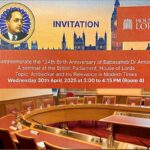
On 16th October 1956, Chandrapur Deekshabhumi (just like Nagpur Deekshabhumi) became the site of a significant moment in India’s social and religious history. On this day, under the leadership of Dr. B.R. Ambedkar, over 300,000 individuals embraced Buddhism and took the pledge to follow his 22 vows, rejecting the caste-based oppression that had defined their lives for centuries. This event followed the larger mass conversion at Deekshabhumi Nagpur just two days earlier, and was part of Dr. Ambedkar’s broader mission to offer his followers a path to dignity, equality, and justice through Buddhism.
Dr. Ambedkar, after retiring from active politics, made the spread of Bodh Dhamma his primary mission. He saw Buddhism as a means to free people not only from caste oppression, but also from the entrenched social inequalities that had plagued Indian society for centuries. His vision extended beyond these mass conversions; his diaries revealed plans for similar ceremonies across India, emphasizing that this was just the beginning of a national movement toward spiritual and social transformation.
Every year on 16th October, this pivotal moment is commemorated through the Dhamma Deeksha event at Chandrapur Deekshabhumi. It is marked by a “Abhivadan Rally”, during which Dr. Ambedkar’s relics are carried, symbolizing his enduring legacy. This rally starts from the statue of Dr Babasaheb Ambedkar in the heart of Chandrapur City and ends at Deekshabhumi, Chandrapur. The event serves as a reminder of Dr. Ambedkar’s life’s work and his efforts to create a Prabuddha Bharat—an enlightened India where equality, liberty, fraternity, and social justice form the foundation of society.
For Ambedkarites, this annual event is not just a remembrance, but a call to continue working toward the vision of a casteless, just society. Dr. Ambedkar believed that true social change could not be achieved solely through political reforms—it required a transformation of mindset and values. This is why he turned to Buddhism, a path rooted in compassion, wisdom, and equality.
The principles he championed—liberty, equality, fraternity—are the same values that were enshrined in the Preamble to the Indian Constitution, which he helped draft. For Dr. Ambedkar, these principles were not just political ideals but were deeply connected to the teachings of Buddhism. They provided a framework for building a society free from discrimination and social hierarchies.
The mass conversion at Chandrapur, like the one at Nagpur, was a step toward realizing that vision. Dr. Ambedkar’s hope was to see an India where caste-based divisions would no longer exist, and where all individuals, regardless of their background, would be treated with dignity and respect. His mission continues to inspire millions who work to ensure that social justice becomes a reality for all.




